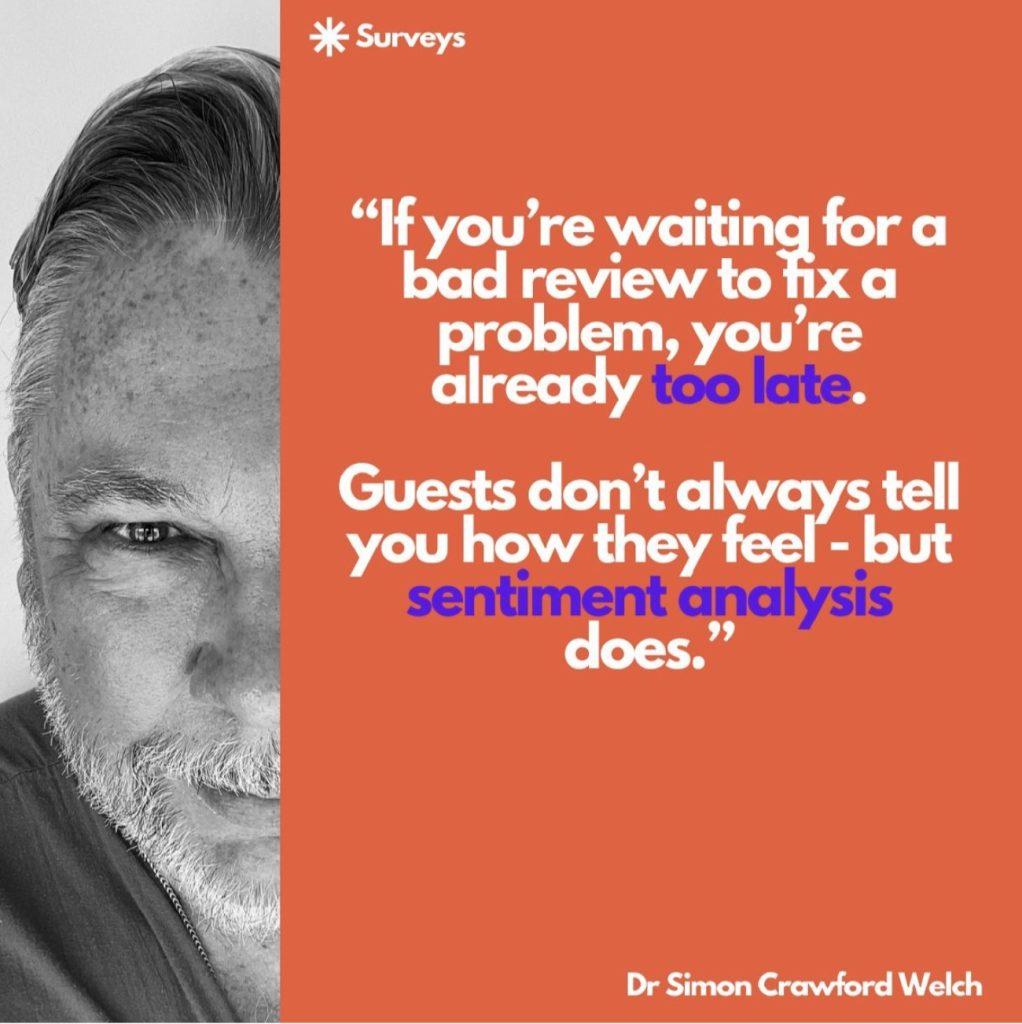By Dr. Simon Crawford Welch
What Are Your Customers Really Feeling?

Let’s set the scene.
You’re the general manager of a boutique resort in Charleston. On the surface, things seem to be running smoothly. Occupancy is high. Reviews are mostly positive. But then your front desk team starts getting odd comments like: “Cute place, but it’s not what I expected.” Or worse: “Beautiful lobby. Too bad the service didn’t match.”
Nobody said anything directly to your face. But something’s off. Guests are quietly walking away dissatisfied – and probably telling hundreds of friends on social media.
That’s where sentiment analysis comes in. It’s not just a tech buzzword. It’s a powerful tool that helps hospitality professionals understand what guests are really saying – before it’s too late.
So, What Is Sentiment Analysis?
In plain English, sentiment analysis (also called opinion mining) uses natural language processing (NLP) to evaluate the emotional tone in text. It tells you if what someone wrote is positive, negative, or neutral – and, in more advanced cases, exactly what they’re happy or upset about.
This could apply to:
- Online reviews
- Survey responses
- Social media posts
- Chat transcripts
- Emails
- Even voice-to-text notes from concierge calls
And it’s not just about tracking complaints. It’s about spotting patterns and trends that you can act on in real time.
How It Works: A Quick Breakdown
Let’s say you’re managing a resort in Cancun. You decide to start using sentiment analysis on your guest feedback.
Here’s how it goes down:
- Data Collection: You gather all text-based feedback: TripAdvisor reviews, Google comments, surveys, and customer service chats.
- Data Processing: The system cleans the data – fixes typos, translates slang or emojis, and structures the info so it’s machine-readable.
- Sentiment Scoring: NLP tools analyze the text and assign a sentiment score – positive, negative, or neutral.
- Aspect Analysis: Then it gets even smarter: the tool figures out which part of the experience the comment refers to. Love the room, hate the check-in line? Now you know exactly what to fix.
- Visualization: All of this is visualized in a dashboard with heat maps, trend graphs, and word clouds, so you don’t have to dig through hundreds of reviews yourself.
Real-World Example: The Breakfast Debacle
Take a popular resort in Orlando. Management started noticing a dip in repeat guests, but the review ratings stayed high.
When they ran sentiment analysis across their feedback channels, a theme emerged: “breakfast,” “wait,” and “slow” kept popping up. Although guests appreciated the rooms and location, they were consistently frustrated by long lines and delays at the complimentary breakfast buffet.
Without sentiment analysis, that insight would have been buried in hundreds of comments. With it, the resort adjusted staffing and food setup – and complaints dropped by 80% in just one month.
Why It’s a Game-Changer for Setting & Managing Expectations
One of the biggest challenges in hospitality? – managing guest expectations. Guests walk in with a mental picture shaped by your website, your reviews, and your brand story. If the reality doesn’t match – even slightly – you could lose their trust.
Let’s say your resort markets itself as a “tranquil retreat.” But sentiment analysis reveals that guests often use words like “noisy,” “busy,” and “wedding crowds.” That’s a red flag. Even if those wedding groups spend money, they may be disrupting your core promise to individual travelers.
You can now take action – maybe by adjusting your marketing, redesigning guest flow, or setting quieter zones. Either way, sentiment analysis gives you the insight before it becomes a 2-star review.
Be Proactive, Not Reactive
Traditionally, resorts relied on comment cards or surveys that guests filled out after checkout. But that’s reactive – you’re fixing problems after the fact.
Sentiment analysis lets you be proactive. You can set up alerts for real-time feedback trends. If guests are suddenly mentioning “dirty towels” or “slow valet,” your ops team can address it that day – not a week later.
At one large resort in Las Vegas, sentiment alerts flagged an unusual spike in complaints around the pool. Turns out, a new towel system was confusing guests and causing delays. A simple signage change fixed it overnight.
It’s Not Just for the Front Desk
Sentiment analysis helps across every department:
- Housekeeping: Spot complaints about cleanliness or noise.
- Food & Beverage: Identify what guests love (the crab cakes!) and what they don’t (the wait for wine).
- Sales & Marketing: Understand what aspects of your experience guests rave about – those become your best marketing assets.
- Training & HR: If one team member is consistently mentioned in negative or glowing terms, you can coach accordingly.
A Few Tools Worth Exploring
You don’t have to build a system from scratch. Here are a few off-the-shelf platforms that offer sentiment analysis, especially useful in hospitality:
- Reputation.com – Tracks guest sentiment across reviews, social, and surveys.
- Medallia – Advanced customer experience platform with sentiment insights.
- Clarabridge (Qualtrics) – Powerful AI that helps dissect complex feedback.
- TrustYou – Especially good for hotels wanting to improve online review performance.
- Hootsuite or Sprout Social – Great for social listening and spotting trends in real time.
Many of these can be integrated with your existing CRM or PMS, giving your team one central hub of insight.
Why This Matters Now More Than Ever
In a post-pandemic world, travelers are more vocal, more connected, and more emotionally attuned to their experiences. They don’t just want a clean room – they want to feel taken care of, understood, and appreciated.
With AI-driven tools like sentiment analysis, hotels, resorts, and restaurants can finally listen at scale. You can understand your guests not just as data points, but as human beings with emotions, expectations, and stories.
And when you consistently align your service with those emotional cues? That’s when the magic happens. That’s when you turn first-time guests into loyal fans – and those fans into your best marketers.
The Bottom Line
- Sentiment analysis helps you decode how guests feel based on what they say.
- It works by analyzing reviews, comments, and messages to identify emotional tone and patterns.
- It’s especially powerful for managing expectations, fixing issues early, and improving service across every department.
- And best of all – it doesn’t just reduce negative reviews. It helps you build trust.
So next time a guest says, “The room was nice, but the vibe was off,” don’t shrug it off. Use sentiment analysis to dig deeper, fix the friction points, and elevate every part of the experience.
Because in hospitality, emotions aren’t the soft stuff – they’re the core of your business.
Simon Crawford Welch, Ph.D., is Founder of The Critical Thought Lab; author of “American Chasms: Essays on the Divided States of America” & “The Wisdom of Pooh: Timeless Insights for Success & Happiness” (Available on Amazon). He acts as an Advisor to hospitality organizations worldwide. www.linkedin.com/in/simoncrawfordwelch



